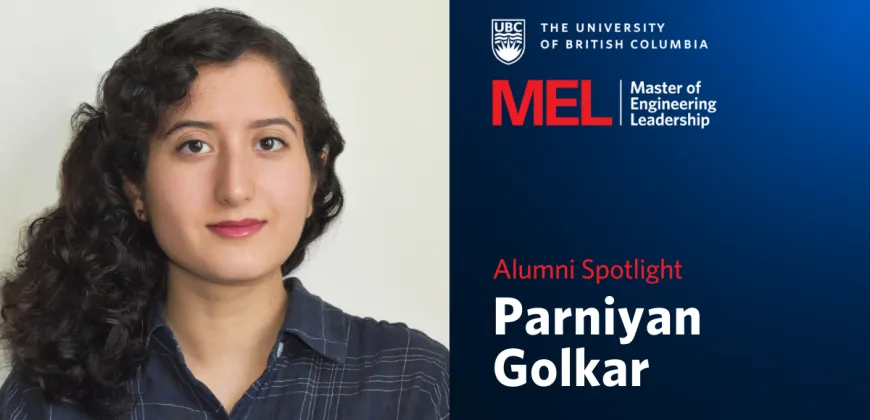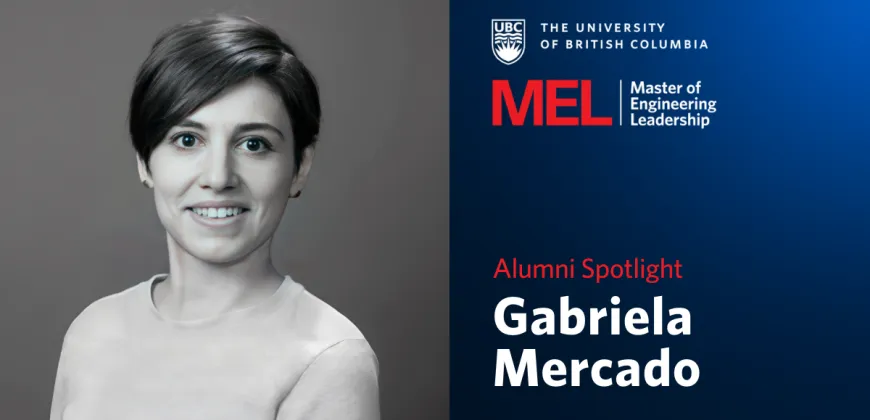Alumni Spotlight: Parniyan Golkar
Parniyan Golkar used the one-year Master of Engineering Leadership degree to expand her knowledge of green building practices and gain new skills in leadership and business.

While working as an architect for EBA[M] in Tehran, Parniyan Golkar contributed to a wide range of projects – from single-family homes and multifunctional spaces to a memorial and an urban design project to pedestrianize a street. With several years of professional experience behind her, she was interested in returning to school to build her knowledge in two key areas: integrated design and sustainability.
“I had worked in a more traditional and linear way, where architects, mechanical engineers and electrical engineers all work separately and check in at the end of a project,” she says. “I wanted to learn about the integrated design approach that is more common here in Canada, and I also wanted to deepen my understanding of what’s required to build climate-resilient buildings.”
When she began researching potential programs, she came across the Master of Engineering Leadership (MEL) in High Performance Buildings and was attracted to its blend of technical and business courses.
“I’d like to move into leadership positions, and I wanted to learn more about how business decisions are made. This felt like a good time in my career to both increase my technical knowledge and learn the foundations of business.”
Integrated Design
The High Performance Buildings program includes architectural courses on green building design and engineering courses on energy modelling and design.
“The course on green building practices in the first term was a great introduction to contemporary practice,” says Parniyan. “We also talked about the role of policy in the built environment and the environmental consequences of what we design and build.”
“Students complete two capstone projects over the year to integrate and apply their knowledge while working with clients.”
The first is an individual project where students are tasked with greening an existing building. Parniyan chose the UBC Music Building, which was built in the late 1960s.
She reviewed data to assess the current environmental performance of the building and then recommended strategies for improvement, including installing a heat recovery ventilator, replacing existing lights with LEDs, using low-flow water supply fixtures, replacing the glazings to double or triple pane, and installing wood fibre acoustic panels.
For the second capstone project, students work as a team and are paired with a local design or construction firm to contribute ideas on how to make a new building as efficient as possible. Parniyan’s team was matched with Thinkspace Architecture, and the group was given a set of drawings and documents for the Ta’talu Elementary School being built in Surrey.
“We explored what would be needed to meet different certification and standard criteria, like LEED, Zero Carbon Building and Passive House and made recommendations on ways to improve the building’s energy efficiency and how it could contribute to occupants’ health and wellness.”
On all group projects, students adopted an integrated design approach. “It’s great to get architects and engineers working together from the very start of a project – it makes the process much easier when you are all on the same page and have the same goals and values,” says Parniyan.
Learning the tools of business and management
About half of the courses in the MEL focus on business and leadership concepts. A particular highlight for Parniyan was the four-week business boot camp course, which provides an intense overview of the foundations of business practice, including business case development, accounting, strategy and operations.
“We had classes in the morning and then gathered with other students in our teams in the afternoon to work on group assignments,” says Parniyan.
“I learned so much from these discussions and from the experiences of the other students in the MEL and the Master of Health Leadership and Policy. Everyone’s professional experience was very different, and it was so interesting to learn about other industries and contexts.”
An internship as a Sustainability Scholar
Parniyan applied for the UBC Sustainability Scholars Program, which matches UBC graduate students with partner organizations to work on sustainability projects. She was thrilled to be accepted into the paid internship program and to work for three months over the summer for the Community Energy Association.
She was responsible for creating an energy and emissions inventory and identifying the highest-emitting building sectors in Kelowna, Penticton and Vernon and suggesting retrofit strategies to minimize impacts. Her analysis affirmed that new policies will be needed to meet current greenhouse gas emissions reduction targets for existing buildings. (Read the executive summary of her report “High-level building energy retrofit strategies for BC communities.”)
A job in her field
In June 2022, Parniyan landed a job as a project manager with E3 Eco Group, a sustainable building consulting firm that helps residential buildings implement energy-efficiency strategies and achieve green certification.
“I connected with E3 through a webinar and on LinkedIn, which is how I knew they were hiring for a position in my area,” she says.
“As project manager, I work with a range of consultants in the design and construction phases, prepare submission packages for the administrative authorities in charge of certification, and communicate feedback on audits of our work.”
Parniyan says that the technical and business courses that make up the degree’s interdisciplinary curriculum have been very helpful in her new role. As important, she says, are the professional connections she made and experiences she had at UBC.
“One of my first projects at E3 was for Evolve, a residential building on the UBC campus. We had actually toured the site during the program with our instructor John Madden, and when I began working at E3 I was the person responsible for finishing the project and certifying it to the Residential Environmental Assessment Program rating system.”
Looking back on the program, Parniyan says it was a valuable year of integrating her professional experience as an architect with her new knowledge of green buildings, sustainability practices and integrated design – setting her up to contribute to greener and more resilient cities.
“It was an interesting year to be studying green building design,” she says. “In July 2021, Vancouver experienced a very intense and unusual heatwave and then in November, the region was battered by catastrophic floods.
These and other events point to the necessity of taking quick steps and doing everything we can in the built environment to minimize the impacts of climate change.”
–
Take the steps to join the next cohort of engineering leaders. If you haven’t already, assess your eligibility and sign up for the upcoming information session to learn how to submit a strong application. Learn more about this innovative master’s program:



